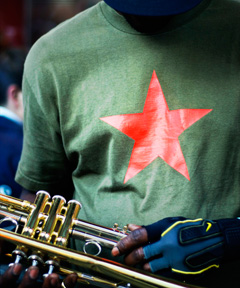In the US, artists and performers of all kinds have the possibility of “making it big” and gaining huge financial rewards. Conventional economic thinking assumes that such “incentives” should promote a high level of effort and achievement in the arts. Is a system that dangles a lot of money before prospective artists actually the best way to promote creative activity? A recent interview with a jazz singer who moved from Moscow to the USA at the end of the Soviet period sheds some interesting light on this question.
Ella Leya, a jazz singer based in Chicago, was interviewed by Scott Simon on National Public Radio's (NPR) Weekend Edition Saturday on April 2 (“Ella Leya: American Jazz by Way of Azerbaijan”). Leya had classical music training in her home city of Baku before she discovered jazz. Falling in love with it, she was able to perform jazz in clubs and produce recordings, as state controls over artists were loosened in the Soviet Union in the late 1980s. Shortly before the demise of the Soviet Union, Leya, by then living in Moscow, emigrated to the US and has pursued a jazz career here.
Leya's interview with Simon was revealing about the different systems for artists in the former Soviet Union and the USA, as well as about the assumptions of NPR staffers. Here is the dialogue from the interview:
Simon: “I gather that you were a big hit in Moscow but earned about as much as a bus driver, which is good and honest work, but probably not what you're thinking when you go into show business.”
Leya: “We recorded an album of children's songs and before even I left the Soviet Union the number of sold recordings stood somewhere abound 3 million and I earned 15 rubles. I wouldn't know how to compare it.”
Simon: “15 rubles is not 15 million dollars, but it's probably closer to, what, a dollar or something?”
Leya: “I don't know, but I have to say that, on the other hand, there was something very pure about being just an artist.”
Following Leya's comment above, Simon gave an uncomfortable sounding grunt and changed the subject.
Under US capitalism, the arts are commercialized. Artists have some access to grants from government and nonprofit institutions, but most creative people having significant talent who want to spend their full time on their art find it difficult or impossible to make a living at it. A very few artists, musicians, and other creative people become rich and famous, but the great majority have to support themselves by relying on other jobs. For example, anyone who wishes to pursue a career as a classical musician faces daunting odds, given the small number of orchestra positions that pay a living wage in the US – odds that persuade most talented, young musicians that it is not a viable career.
The Soviet Union was not a very positive model of an alternative socialist economy – but it did build a noncommercial system for supporting the arts. The profit motive did not play any role in the Soviet system and significant resources were devoted to training talented artists and musicians and supporting careers in the arts. A normal living standard was a reasonable expectation for a young person with creative talent who decided to pursue the arts as a career. The most successful achieved fame – but not fortune.
The Soviet system produced both world-class musicians and a large number of opportunities for talented musicians, who would never become famous in the many orchestras and other musical venues supported by the state plan. Musical performances were well attended, both because the educational system taught appreciation of music and because the ticket prices were kept very low. Orchestras and other musical performance institutions did not have to show a profit.
Of course, the Soviet system for supporting the arts had big negative features. Along with state support went state control. Artists had to follow the Communist Party's current position about which kinds of art were acceptable and which were not. This caused problems for artists whose creativity led them outside the boundaries of what was politically approved. This may not have been a problem for a classical musician, who received all the benefits of a state-supported system without the disadvantages of the heavy-handed Soviet control of the arts. However, it was a problem for those artists who wanted to transgress the boundaries as well as an obstacle to the development of artistic creativity.
Nevertheless, this comparison of the two systems for supporting the arts goes against the smug view of mainstream commentators that the US commercialized system is the ideal one, or even a good system. One could imagine a socialist system in which artists were supported in their work out of public funds, but retained the freedom to pursue their work as they chose. This would recognize that the encouragement of artistic expression has large social benefits that extend far beyond what can be captured by ticket revenues and royalties. The Soviet example, despite its problems, did show that the promise of getting rich is not necessary to promote an outpouring of artistic creativity, including the development of those with outstanding talent. The US example suggests that organizing the arts commercially – which leads to a “star” system in which a very few get outsize rewards, while most get little or nothing – restricts the expression of artistic creativity and distorts its inherently noncommercial character.
